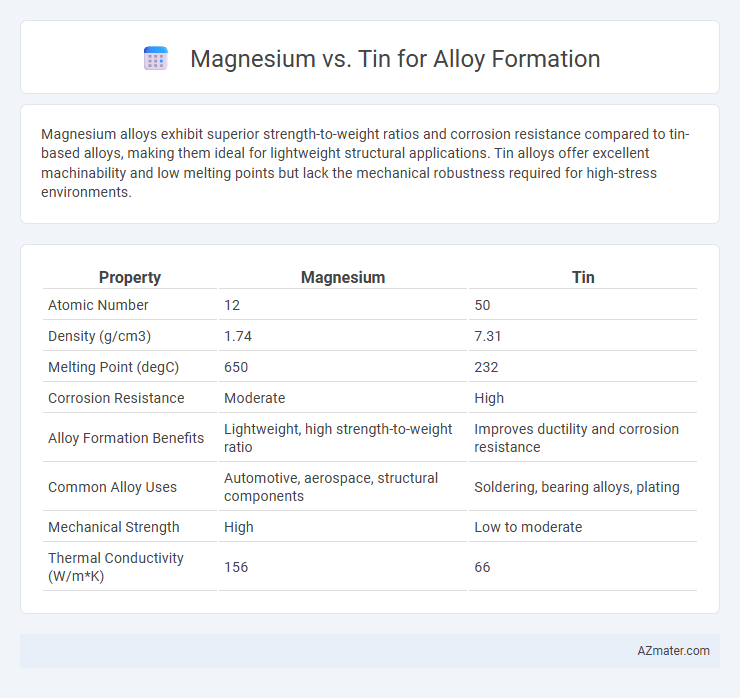Magnesium alloys exhibit superior strength-to-weight ratios and corrosion resistance compared to tin-based alloys, making them ideal for lightweight structural applications. Tin alloys offer excellent machinability and low melting points but lack the mechanical robustness required for high-stress environments.
Table of Comparison
| Property | Magnesium | Tin |
|---|---|---|
| Atomic Number | 12 | 50 |
| Density (g/cm3) | 1.74 | 7.31 |
| Melting Point (degC) | 650 | 232 |
| Corrosion Resistance | Moderate | High |
| Alloy Formation Benefits | Lightweight, high strength-to-weight ratio | Improves ductility and corrosion resistance |
| Common Alloy Uses | Automotive, aerospace, structural components | Soldering, bearing alloys, plating |
| Mechanical Strength | High | Low to moderate |
| Thermal Conductivity (W/m*K) | 156 | 66 |
Introduction to Magnesium and Tin in Alloy Formation
Magnesium is favored in alloy formation for its low density and excellent strength-to-weight ratio, making it ideal for aerospace and automotive applications requiring lightweight materials. Tin, known for its corrosion resistance and malleability, is commonly alloyed with other metals to improve solderability and enhance surface protection. Combining magnesium and tin in alloys can optimize mechanical properties and corrosion resistance, benefiting industries that demand durable yet lightweight components.
Physical and Chemical Properties: Magnesium vs Tin
Magnesium exhibits a low density of 1.74 g/cm3 and a melting point of 650degC, making it lightweight and moderately heat resistant, whereas tin has a higher density of 7.31 g/cm3 and a low melting point of 232degC, enabling lower-temperature alloy processing. Chemically, magnesium is highly reactive, especially prone to oxidation and corrosion under atmospheric conditions, while tin demonstrates superior corrosion resistance and stability in various environments. Alloy formation with magnesium often leverages its strength-to-weight ratio and reactivity, while tin contributes malleability and corrosion protection, influencing the choice based on desired physical durability and chemical stability.
Historical Overview of Alloy Use
Magnesium and tin have been pivotal in alloy formation since ancient times, with tin historically used in bronze alloys around 3000 BCE, significantly advancing metal tool and weapon manufacturing. Magnesium's alloying prominence rose notably in the 20th century due to its lightweight properties, crucial for aerospace and automotive industries. Both elements contributed to evolving metallurgical techniques, reflecting shifts from durability-driven bronze to performance-enhanced magnesium alloys in modern applications.
Comparative Alloying Behaviors
Magnesium and tin exhibit distinct alloying behaviors due to their atomic structures and bonding characteristics. Magnesium alloys offer superior strength-to-weight ratios and enhanced corrosion resistance, making them ideal for lightweight applications, while tin alloys provide excellent malleability and low melting points suitable for soldering and coatings. The choice between magnesium and tin for alloy formation depends on desired mechanical properties, thermal stability, and specific industry requirements such as automotive, aerospace, or electronics.
Strength and Durability: Magnesium vs Tin Alloys
Magnesium alloys exhibit superior strength-to-weight ratios and enhanced corrosion resistance compared to tin alloys, making them ideal for aerospace and automotive applications where durability is critical. Tin alloys typically offer lower tensile strength but provide excellent ductility and corrosion protection, often used in coatings and soldering rather than structural components. The choice between magnesium and tin alloys fundamentally depends on the required mechanical performance and environmental resistance in the final application.
Corrosion Resistance and Environmental Stability
Magnesium alloys exhibit superior corrosion resistance due to the formation of a stable oxide layer that protects against environmental degradation, whereas tin primarily enhances corrosion resistance when alloyed with other metals by providing a protective sacrificial layer. Tin's environmental stability is notable in low-temperature applications but may suffer in highly acidic or alkaline environments compared to magnesium alloys. Combining magnesium with tin in alloy formation can improve overall corrosion resistance and environmental durability by leveraging magnesium's passivation characteristics and tin's anti-corrosive properties.
Industrial Applications of Magnesium and Tin Alloys
Magnesium alloys are prized in aerospace and automotive industries for their high strength-to-weight ratio and excellent corrosion resistance, enabling lightweight construction and fuel efficiency. Tin alloys, commonly used in soldering and bearing materials, offer superior malleability and low melting points, ideal for electronic and mechanical applications requiring precise joining and wear resistance. The industrial application of these alloys leverages magnesium's lightweight structural benefits and tin's adaptability in surface coatings and lubrication components.
Cost-Effectiveness and Resource Availability
Magnesium offers greater cost-effectiveness and widespread availability compared to tin, making it a preferred choice for alloy formation in large-scale industrial applications. Tin's higher market price and limited resource deposits contribute to increased material costs and supply challenges. Magnesium alloys provide a favorable balance of lightweight strength and affordability, enhancing their economic viability in manufacturing sectors.
Technological Advancements in Alloy Processing
Magnesium-tin alloys exhibit enhanced corrosion resistance and lightweight properties, driving their increasing use in aerospace and automotive industries. Recent technological advancements in alloy processing, such as high-pressure torsion and spark plasma sintering, optimize the microstructure and mechanical strength of these alloys. Innovations in additive manufacturing also enable precise control over magnesium-tin alloy compositions, improving durability and performance in critical applications.
Future Trends in Magnesium and Tin Alloy Development
Emerging innovations in magnesium and tin alloy development emphasize lightweight, high-strength applications for aerospace and automotive industries, driven by increasing demands for fuel efficiency and sustainability. Advanced processing techniques like additive manufacturing and nano-structuring enhance the mechanical properties and corrosion resistance of magnesium-tin alloys, expanding their usability in critical structural components. Future trends prioritize eco-friendly production methods and improved recyclability, positioning magnesium-tin alloys as pivotal materials in next-generation engineering solutions.

Infographic: Magnesium vs Tin for Alloy Formation
 azmater.com
azmater.com